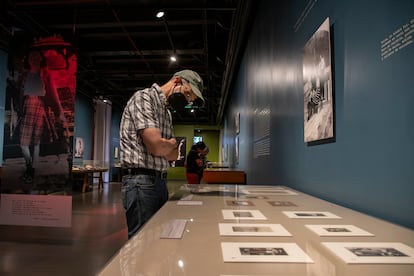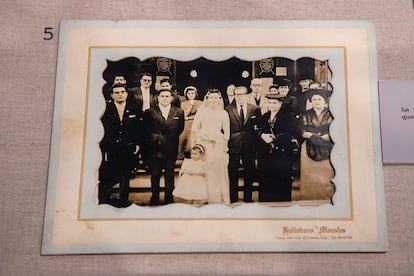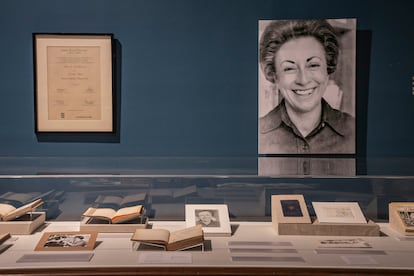If Macondo resonates as the magical place where miracles occur and inhabit the ghosts of the Latin American tragedy, committeen, in the state of Chiapas, it is the microcosm of social tensions, cultural clashes and gender submission that announces and denounces the work of the Mexican writer Rosario Castellanos, which this Sunday would have celebrated his hundred birthday. Both villages, one imaginary and the other real, become territories that warn from literature the tensions that are still present in the continent, but it is perhaps in that space of oppression recreated by Castilians where the oppressive silence of women, racism and marginalization of indigenous cultures were more powerfully. It is the powerful voice of a writer committed to change. “You can’t write what Rosario Castellanos wrote if you don’t have enormous sensitivity,” says Gabriel Guerra, the only son of the writer. “I had a huge commitment to issues that at the time were a taboo, badly seen or that generated noise,” he explains.
Now that the hundred years of the birth of Castellanos are completed, the world of politics and culture is filled with tributes. His books are reissued, they release plays, open exhibitions in museums and academies organize conversations about their literary creation. But the author so celebrated today faced a wall that was difficult to destroy, that of machismo. “The world that is closed for me has a name: it is called culture. Its inhabitants are all of them of the male sex,” he denounced. That is why his work was a pioneer in raising his voice against the oppression of women, an issue he addressed in novels today held as OFFICE OF DAREBLAS y Canon balloon. “He confronted power, and when I say power, I not only mean the government, but to the establishment, the factual powers, the many machisms of the intellectual cacicazgos,” says Guerra.
And he did it with an overflowing imagination of Comitán’s memories, a place turned by her into almost mythical, in which he had his first clashes with a colonial reality, where he suffered his personal tragedies and where his ghosts inhabit. The Nation writer in Mexico City on May 25, 1925, but her childhood lived in that town of Chiapas, to southern Mexico, an impoverished, unequal region and where there was then a deep classes division, which crushed (and still doing so) to the indigenous people. “We were the masters, but we didn’t know. Canon balloon.
The poet Sara Uribe, who delved into the life of the writer in her work Matter that burns (Lumen), remember in it that Castellanos is part of a world marked by class differences. “The children of the patterns received for their entertainment a creature of the same age. As she described it, that girl sometimes became a playmate and sometimes both in mere object in which the other discharged her moods: the inexhaustible energy of childhood, boredom, anger, the bitter zeal of possession,” writes Uribe using quotes of the author herself. “When Rosario noticed that his loader was, in effect, a person, he decided, for the rest of his life, not to use his position of power to humiliate another,” says Uribe.
So hard will have been that discovery, that the writer spent a good part of her life with the commitment of the indigenous cause, denouncing structural racism, inequality and overwhelming. “He traveled to the Sierra in Chiapas taking theater to remote indigenous communities. He made two or three days in mule or horse to reach those communities,” recalls his son.
If indigenous oppression aroused a deep feeling of commitment, personal tragedies marked her forever. Her ghosts are her brother, Mario Benjamin, of whom she acknowledged that “she was born owner of a privilege that no one would dispute her: to be male.” The younger brother, worshiped by the parents and by whom Castellanos felt in the background, died from an intestinal obstruction in 1933. “Why the male, why the male?”, Their parents lamented. That child would never stop populating his dreams.
His parents, who never exceeded the death of Benjamin, died when Castellanos was 20 years old, which represented, in addition to loss, a kind of liberation. Castellanos traveled to Mexico City, studied philosophy at UNAM and immersed himself in the world of literature, publishing his first poems. She was a tireless, disciplined and ambitious writer. His son remembers the CLAC, CLAC, constant clac of the mother’s writing machine, which marked a daily rhythm and a warning: when she was locked in her literary world, he did not approach. “I locked up with the typewriter to typing. And there is a method that was like my signal, because when the machine’s noise ended I could look out. You could be with her in those moments of writing, but you knew that I was going to ignore you and that I was going to turn to see you with face I’m working. “

Guerra lost his mother at age 12. The version that has been known is that it was electrocuted in his home in Israel, where he served as an ambassador of Mexico designated by President Luis Echeverría, when leaving the bathtub with wet feet to fix the focus of a lamp that did not work. The son was on vacation in Mexico, because Castellanos insisted that he spend his summers with his father, the philosopher Ricardo Guerra Tejada, because, she says, she insisted that he maintained the father figure. “I was very affectionate, very warm, close, very reading things, telling me stories. I also have a very pleasant memory, very warm in recent years in Israel, where we were together because she was very happy there,” Guerra recalls. Castellanos was ambassador to that country for three years. “It was a very productive stage for her, with a lot of work. I remember my vibrant, happy, happy, excited mother of the things she was doing, writing with a lot of discipline,” he adds.
The relationship with the philosopher was complex, despite the love and admiration he professed, according to his correspondence. Some biographers from Castellanos, however, claim that there were also jealousy from war, as well as resentment for the productive capacity of Castilians and their growing success. The couple separated, but the son remembers that it was “a very civilized divorce, because the two were very careful to preserve, maintain, promote my relationship with the other. That is, my dad spoke to me badly about my mother. My mother didn’t speak badly about my dad,” he emphasizes.
Guerra rejects the vision of Castellanos as a melancholic woman, sad, overwhelmed by ghosts. “I don’t share that victimizing vision,” he clarifies. “The rejection, because it seems to me that he leaves aside a good part of his biography, a good part of his creation and the part that I lived, that I met from her. You cannot be a melancholic and self -absorbed and be in the mountains in Chiapas helping indigenous communities. I think that with those visions they were looking for by all possible means to try to minimize, reduce women and what better way to do it. Melancholic. ‘
The son prefers to keep the image of the committed woman, the tireless writer, the pioneer of feminism, the combative intellectual, the poet, the official and the diplomat. An exhibition at the College of San Ildefonso reviews that short, but intense life, which begins with the writing machine that Castellanos bought with effort, because at that time it was a expensive work tool, and that is why the machine is accompanied by the purchase receipt because, as her son says, “she was a very orderly woman.”
The exhibition brings together photos, manuscripts, daily, purchase receipts, the author’s literary work and her passion for helping the indigenous people of Mexico. “The exhibition is based on small details,” says Juan Pablo López Quintana, researcher at the San Ildefonso Exhibition Department. “We wanted to show this human and daily part of a writer of her level, although the most important thing is to continue reading it, because her ideas still have validity, with her very clear point of view in politics, in the inequalities and differences between men and women,” he explains. If Macondo is the magical place where miracles occur, the world of Rosario Castellanos, his committee, which is exhibited in San Ildefonso, is the microcosm of the announcement and the complaint.


